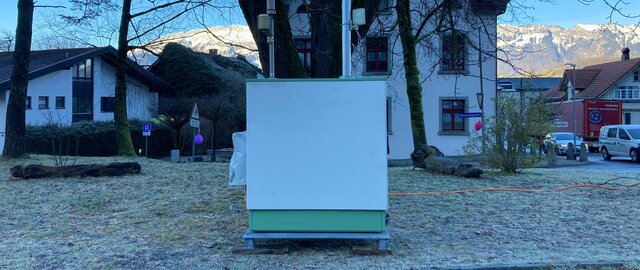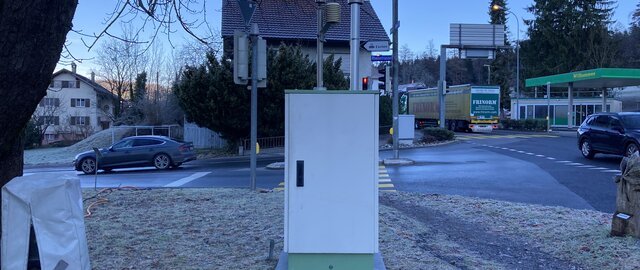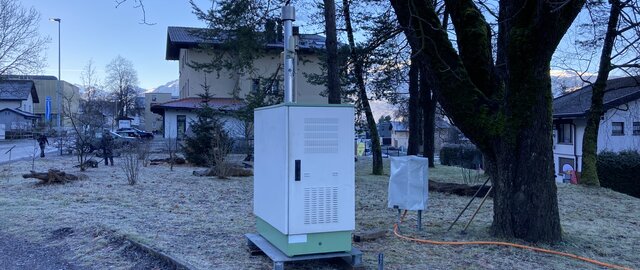Air quality
Air quality monitoring in Liechtenstein is carried out jointly with the cantons of Eastern Switzerland as part of OSTLUFT. In addition, the Office of Environment carries out supplementary measurements. The air pollutants particulate matter, nitrogen oxides, ozone, organic compounds and ammonia are measured.
Current measured values for eastern air
The monitoring of air quality in Liechtenstein has been carried out jointly with the cantons of Eastern Switzerland as part of Ostluft since the beginning of 2001. The current measurement data and information on the immission measurements can be found on the joint Ostluft homepage.
Current immission measurement data for eastern air
Current particulate matter measurements (PM10) in Liechtenstein
The Office of Environment uses a mobile measuring station to measure air quality (with a focus on particulate matter) at various locations, particularly those with high levels of traffic. These measurements are carried out in addition to those at the fixed OSTLUFT measuring station in Vaduz. In 2024, the mobile measuring station will be in operation at the Engelkreuzung intersection in Nendeln.
The data presented here are raw values that cannot always reflect the "real air hygiene situation" in the whole of Nendeln. Local exhaust plumes or measurement errors can therefore influence the data.

Compared to the previous week, particulate matter levels were lower in week 19. The weekly average value in Nendeln was 9 µg/m3. An average particulate matter concentration of 8 µg/m3 was measured at the Vaduz National Library. The highest daily average was measured at both measuring stations on Saturday (12 and 11 µg/m3 respectively). The daily average limit value of 50 µg/m3 was complied with at both monitoring sites. The lowest concentration of particulate matter was measured in Nendeln on Tuesday at 6 µg/m3. In Vaduz, pollution was also at its lowest on Tuesday (daily average: 5 µg/m3). There was precipitation and high humidity at the beginning of the week, followed by dry weather from Thursday until Mother's Day on Sunday. The average daily temperatures were between 12°C and 19°C (source: Meteostation Vaduz).
Overview of particulate matter measurements in Liechtenstein
Current particulate matter pollution in Switzerland and Liechtenstein
In order to depict the exposure of the population and the environment to Air pollutants throughout Switzerland, maps on Air pollution are generated from measurement data and model calculations. These maps also include the values from the Vaduz station.
Nitrogen dioxide measurements (NO2)
Nitrogen oxides are among the main air pollutants. They include nitrogen monoxide (NO) and nitrogen dioxide (NO2). The main sources are motorized road traffic (combustion processes, at high temperatures) and furnaces
Nitrogen dioxide is measured at 15 locations using passive samplers. The measurement locations and the corresponding measurement data can be viewed in the appendix of the OSTLUFT annual report
Ozone (O3)
Ozone (O3) occurs naturally in minute quantities in the air we breathe. At ground level - in the Air we breathe - too much ozone is harmful. Higher up - in the stratosphere - it protects us from the sun's dangerous ultraviolet radiation.
Ground-level ozone is the most important component of summer smog.
Ozone is measured at the Vaduz National Library measuring station, among others. The measured values can be viewed on the pollution map from OSTLUFT.
Ammonia measurements (NH3)
Ammonia (NH3) is a nitrogenous air pollutant that contributes significantly to the over-fertilization of sensitive ecosystems. The main source of ammonia is agricultural livestock farming. Ammonia emissions have been measured at various locations in Liechtenstein since 2008.
In addition, Liechtenstein took part in a total nitrogen deposition measurement in 2019 with a measuring point in Ruggeller Riet. The results have been published by the Swiss Federal Office for the Air (FOEN).
A detailed study has taken a closer look at the nitrogen deposition situation in Liechtenstein.
BTEX measurements
The EU has introduced an annual average limit value of 5 µg/m3 for benzene in outdoor air. Due to the carcinogenic properties of benzene, it should be noted that compliance with this limit value should not be interpreted to mean that there is no longer a health risk. To monitor the concentration of benzene and other organic pollutants (toluene, ethylene benzene and xylenes), immission measurements are carried out at seven locations using passive samplers.
Lichen mapping
Lichens are sensitive organisms consisting of fungi and algae that react extremely sensitively to changes in environmental conditions. Air quality in particular is a decisive factor for the survival of lichens. After 1989 and 1999, lichen mapping was carried out in Liechtenstein for the third time in 2009.
Further information
Laws
Contact persons
-
Bettina Göldi Bettina.Goeldi@llv.li +423 236 6891


